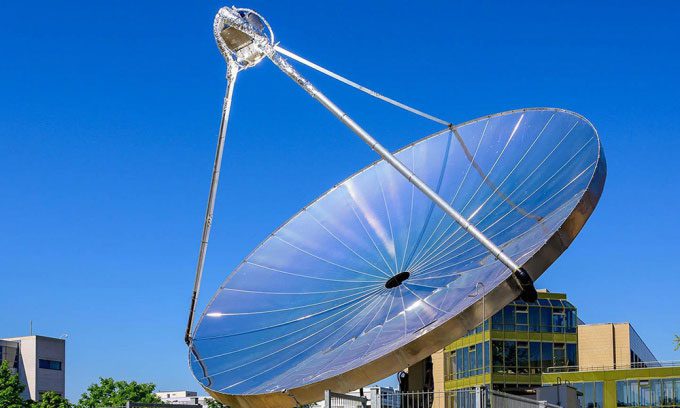In the experiment, the new reactor produced about 500 grams of hydrogen per day, meeting approximately half of the electricity needs of a family of four.
Engineers at the École Polytechnique Fédérale de Lausanne (EPFL) have successfully designed and tested a solar energy reactor that can produce hydrogen from sunlight and water, as reported by New Atlas on April 17. The new system not only achieves high efficiency in hydrogen production but also captures by-products including oxygen and heat for use. This new research was published in the journal Nature Energy.

The parabolic dish plays a crucial role in the solar reactor for hydrogen production. (Photo: EPFL)
Hydrogen plays a vital role in renewable energy. One of the most efficient ways to produce hydrogen is by splitting water into its constituent molecules. This process, performed using solar energy, is referred to as artificial photosynthesis.
The EPFL reactor resembles a satellite dish and operates on a similar principle – its large curved surface area captures as much sunlight as possible and focuses it onto a small device suspended in the center. In this case, the dish collects thermal energy from the sun and concentrates it approximately 800 times into an electrochemical reactor. Water is pumped into this reactor, where solar energy helps to split the water molecules into hydrogen and oxygen.
The reactor captures two by-products of the hydrogen production process that are often wasted: oxygen and heat. Oxygen can be used in hospitals or for industrial purposes, while heat is transferred through a heat exchanger, which can assist in heating water or warming buildings.
The research team tested the reactor at the EPFL facility for over 13 days in August 2020, February, and March 2021, to understand how it operates under various weather conditions. The solar-to-hydrogen energy conversion efficiency averaged above 20%, generating approximately 500 grams of hydrogen each day. The research team stated that with this output, over a year, the system could power 1.5 hydrogen fuel cell vehicles (with average travel distances) or meet about half of the electricity needs of a family of four.
“With an output power of over 2 kW, we have broken the 1 kW ceiling for the pilot reactor while still maintaining a record-high efficiency at this scale. The hydrogen production achieved in this new study shows encouraging progress in commercializing this technology,” said Sophia Haussener, a member of the research team.
The research team plans to build a pilot plant with a capacity of several hundred kW at a metal production facility. Hydrogen will be used for metal processing, heat will be utilized to heat water, and oxygen will be supplied to nearby hospitals.


















































